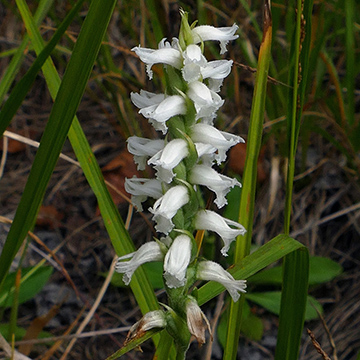

Spiranthes sheviakii - (image 1 of 5)
Taxonomy
Family: Orchidaceae
Habitat
Habitats similar to those of S. ochroleuca and sometimes occurring with it; acidic, dry to mesic successional habitats, open barrens, old fields, and thickets undergoing succession to oak-hickory and mixed hardwood-pine forests. It also occurs in dry open woodland on bluff crowns and ravine rims in the southern portion of its range. Soils typically sandy, silty, or clayey.
Associates
Distribution
Southeastern corner of Lake Ontario in New York; Lake Erie region in northern Ohio, northwestern Pennsylvania, western New York, and southern Ontario; a few interior sites in Ohio; scattered locations across the sandplains near Lake Michigan from southwestern Michigan to northwestern Indiana, and southward into north-central Illinois; increasing in abundance near the Ohio River valley in southern Illinois and Indiana; range likely extending south into western Kentucky, western Tennessee, and northern Arkansas where it would strongly overlap the range of S. cernua.
Morphology
Perennial to 50 cm. Roots few, slender, horizontally spreading to descending, 2–6 mm diameter. Leaves 1–4(–6), erect spreading to flaccidly spreading, persisting until after anthesis or browning shortly before, linear-lanceolate to oblanceolate, rarely obovate, 7–23 cm long, the widest blade to 1–2 cm wide; petiole of lower leaves often slender. Spikes tightly spiraled, 3–4 flowers per cycle, usually not evenly ranked; rachis moderately to densely pubescent with stalked glands. Flowers nearly white to ivory, slightly to strongly nodding, moderately gaping; floral bracts green, stipitate glandular on the abaxial surface and margins, 6–13 mm long, concave, acuminate, incurved over the base of the flower; sepals distinct to the base; lateral sepals 9–11.5 mm × 2–3 mm, appressed, ±straight in profile, the apices typically incurved over the top of the dorsal sepal and petals; dorsal sepal and petals moderately to densely stipitate glandular on the outer surface, linear-lanceolate, 9–11.5 mm, recurved and obtuse at the apex; labellum centrally pale yellow or orange-yellow, oblong or ovate in general outline, slightly constricted in the middle, not or scarcely dilated at the base, 10.0–14.5 × 3.5–6.0 mm, abaxial glands spherical, margins lacerate above the middle, apex obtuse to acute, glabrous; veins several, branches parallel; basal calli usually prominent, 0.7–1.4 mm; viscidia linear; ovary moderately to densely pubescent with stipitate glands, 4.8–6.3 mm. Seeds mostly polyembryonic but some monoembryonic present. 2n=60.
Notes
Flowers mid September to early October in the northern portion of its range; late September to late October in the southern portion of its range.
Wetland indicator: NA
This species is named in honor of Charles J. Sheviak, former Curator of Botany at the New York State Museum who, recognizing its unique morphology, range, and habitat preference, originally described this species as the 'old field ecotype' of S. cernua s.l. (Sheviak 1982).
It is apparently an ancient hybrid of S. ochroleuca with another member of the Spiranthes cernua complex. Other species derived from hybridization with S. ochroleuca include S. arcisepala and S. casei. The overall morphology of the flowers is most similar to those of S. cernua, being rather slender with the lateral sepals typically incurved at the tips over the top of the flower, however the lip is more centrally thickened, with prominent abaxial glands, and the central portion ranging from pale yellow to a deep orange-yellow.
As stated in the original description of S. sheviakii, it is not completely clear that S. cernua is one of its parents given that S. cernua is tetraploid and S. ochroleuca is diploid. Hybrids of tetraploid and diploid parents are typically triploid, not tetraploid as is the case for S. sheviakii. To date no diploid individuals have been identified that have been determined to be S. cernua. The chromosome number of S. ×kapnosperia is currently unknown.
Nevertheless, Pace (2023) synonymizes S. sheviakii with S. ×kapnosperia based on the argument that the International Code of Nomenclature for Algae, Fungi, and Plants (Turland et al. 2018) only allows for one correct name for a hybrid formula. Catling (2023) counters that while this is correct in the case of nothotaxa, the same code states that "taxa believed to be of hybrid origin need not be designated as nothotaxa (H 3 Note 1)". Spiranthes sheviakii was not originally described as a nothotaxon, but rather as a new species of independent origin. Additionally its diagnosis excluded S. ×kapnosperia and therefore the name is not superfluous (Catling 2023).
Other cases of allopolyploid species having the same hybrid parents include Helianthus deserticola Heiser, H. paradoxus Heiser, and H. anomalus S.F. Blake, all of which having arisen through hybridization of H. annuus L. with H. petiolaris Nutt. These names are currently recognized by Plants of the World Online (2024).
References
Catling, P.M. and Kostiuk, B. 2023. Old field ladies'-tresses - still a distinctive taxon. Native Orchid Conference Journal, 20(3): 28-30.
M. Hough and M.A. Young. 2021. A systematic survey of the Spiranthes cernua species complex (Orchidaceae) in New York. Native Orchid Conference Journal, 18(3): 22-56.
Pace, M.C. 2023. Independent origins of Spiranthes ×kapnosperia (Orchidaceae) and their nomenclatural implications. Phytokeys 2023: 226: 89-100.
Pace, M.C. and Cameron, K.M. 2017. The systematics of the Spiranthes cernua species complex (Orchidaceae): Untangling the Gordian Knot. Systematic Botany, 42(4):1-30.
POWO (2024). "Plants of the World Online. Facilitated by the
Royal Botanic Gardens, Kew. Published on the Internet; http://www.plantsoftheworldonline.org/
Retrieved 03 February 2024."
Sheviak, C.J. 1982. Biosystematic study of the Spiranthes cernua complex. New York State Museum Bulletin No. 448.
|
Michael Hough © 2021 |